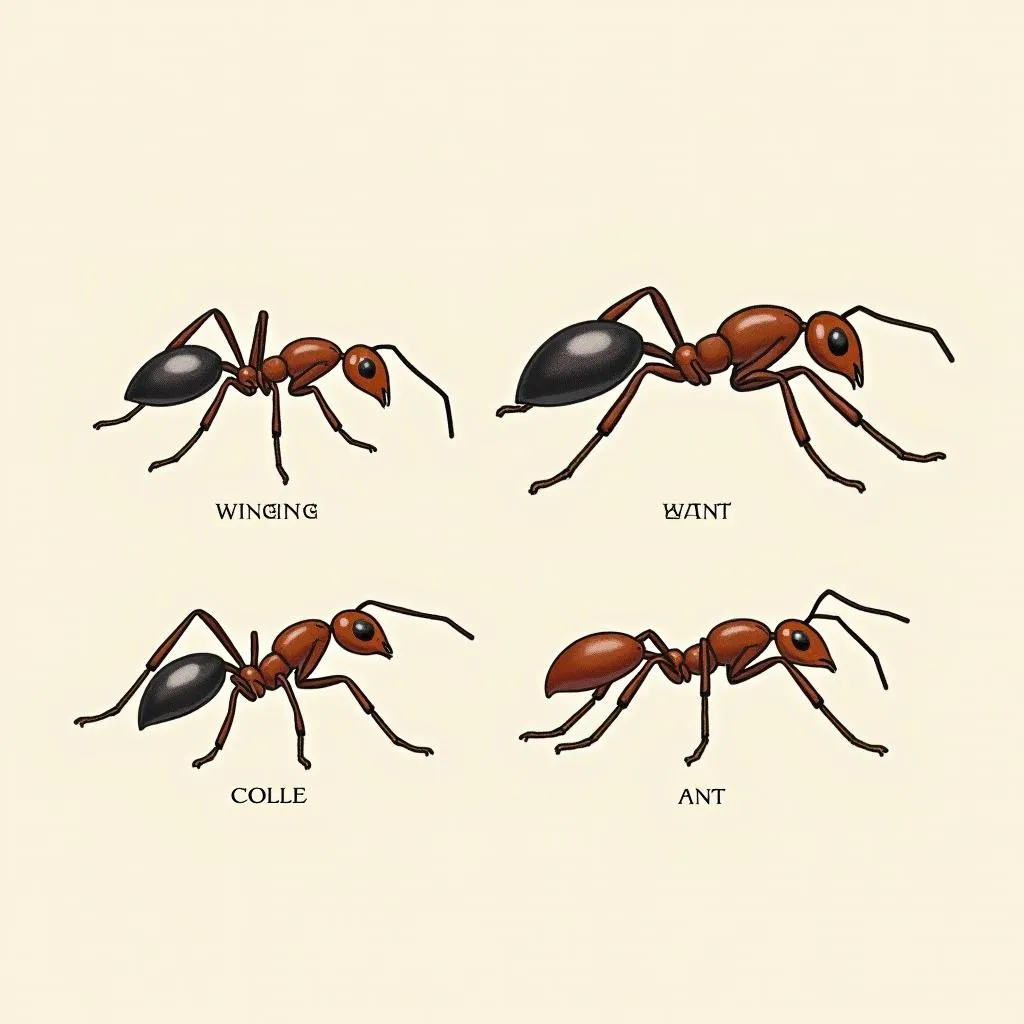The question of whether ants can see color has fascinated scientists and nature enthusiasts for years. These tiny creatures, renowned for their strength and organizational skills, navigate a world that appears vastly different from our own. While we rely heavily on our sense of sight, ants experience their surroundings through a combination of senses, with sight playing a surprisingly complex role. So, can ants see color? The answer, like the world of ants themselves, is more intricate than a simple yes or no.
How Ant Vision Works: A Different Perspective
To understand ant vision, we need to delve into the structure of their eyes. Unlike our single-lens eyes, ants possess compound eyes made up of numerous individual units called ommatidia. Each ommatidium functions as a miniature lens, capturing a tiny portion of the insect’s visual field. These individual images are then pieced together by the ant’s brain, creating a mosaic-like perception of their surroundings.
 Ant compound eye structure
Ant compound eye structure
The number of ommatidia in an ant’s eye can vary greatly depending on the species and its lifestyle. Ants that rely heavily on vision for navigation, like those inhabiting open environments, tend to have more ommatidia, granting them a wider field of view and greater visual acuity. In contrast, subterranean species that dwell in darkness may have fewer ommatidia, reflecting their reduced dependence on sight.
Color Perception in Ants: Beyond Black and White
While ants don’t perceive color in the same way humans do, research suggests that they are not colorblind. They can detect certain wavelengths of light, indicating a capacity to differentiate between some colors. Studies have shown that ants are particularly sensitive to ultraviolet (UV) light, which is invisible to the human eye. This UV sensitivity plays a crucial role in their navigation, as they use the sun’s position in the sky as a compass.
 Ant using UV light for navigation
Ant using UV light for navigation
Beyond UV light, some ant species have shown sensitivity to other parts of the color spectrum, including green and blue. However, their color perception is likely less nuanced than ours, with a limited ability to discriminate between subtle shades. Instead of seeing a vibrant rainbow, ants may perceive the world in more muted tones, focusing on contrasting patterns and light intensities.
The Role of Color in the Ant World: Communication and Beyond
Despite their limited color vision compared to humans, color still plays a vital role in the lives of ants. While scent trails remain their primary mode of communication, some species utilize visual cues, including color, for specific purposes. For instance, certain ant species display brightly colored body parts, which they use for signaling and recognition within their colonies.
 Ants using color for communication
Ants using color for communication
Furthermore, color can influence an ant’s foraging behavior. Studies have shown that some ants are more attracted to particular colored objects, suggesting an innate preference for specific wavelengths of light. This preference could be linked to the color of their preferred food sources or nesting materials, demonstrating the practical implications of color perception in their daily lives.
Conclusion: Seeing the World Through Different Lenses
So, can ants see color? While they may not experience the world in the same vibrant hues as we do, their ability to perceive certain wavelengths of light, including UV, allows them to navigate, communicate, and interact with their environment in remarkable ways. Their unique vision system reminds us that even the smallest creatures possess extraordinary adaptations that enable them to thrive in their own fascinating ways.
FAQs
1. Do all ant species see color the same way?
No, color perception can vary between ant species. Some are more sensitive to certain wavelengths of light than others, depending on their ecological niche and behavioral patterns.
2. How does an ant’s vision compare to a human’s?
Ants have compound eyes, which create a mosaic-like image, while humans have single-lens eyes that produce a clearer, more focused image. Ants also see UV light, which is invisible to humans, but their overall color perception is less nuanced.
3. Why do some ants have brightly colored body parts?
Bright coloration can serve various purposes, including species recognition, signaling within the colony, and even deterring predators.
4. How does color influence an ant’s behavior?
Color can affect an ant’s foraging preferences, attracting them to specific colored objects associated with food or nesting materials. It can also play a role in communication and recognition within the colony.
5. What can we learn from studying ant vision?
Studying ant vision provides insights into the diversity of sensory adaptations in the animal kingdom and helps us understand how different species perceive and interact with their surroundings.
Need Help With Your Home’s Colors?
Are you looking to add a splash of color to your home? Our team at Color Box Hanoi can help! Contact us today at 0373298888 or [email protected], or visit our showroom at 86 Cầu Giấy, Hanoi. We offer 24/7 customer support and a wide range of colors and design services to bring your vision to life!

